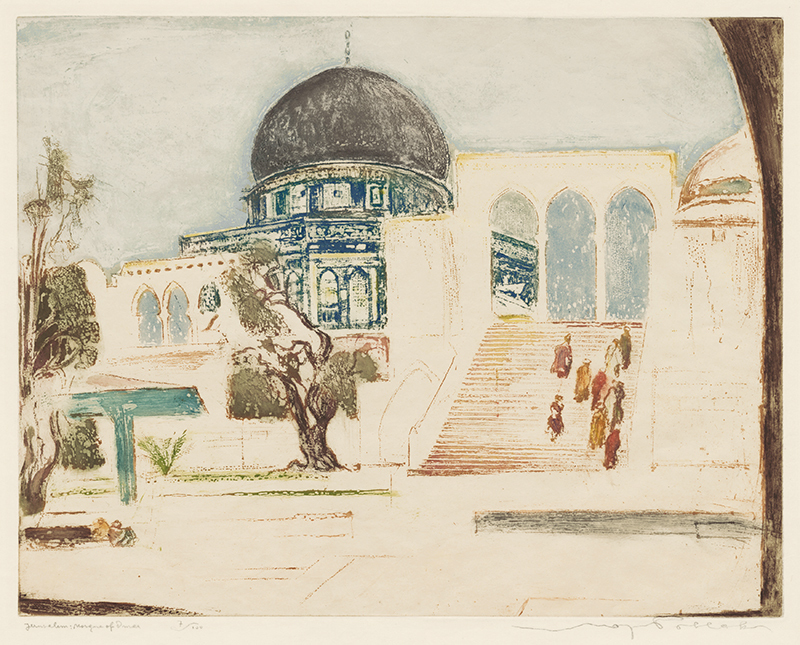
19th, 20th & 21st Century Fine Prints
707-546-7352 · fax 707-546-7924 · web: www.annexgalleries.com · email: artannex@aol.com
Jerusalem: Mosque of Omar (Dome of the Rock) by Max Pollak

Jerusalem: Mosque of Omar (Dome of the Rock)
Max Pollak
Jerusalem: Mosque of Omar (Dome of the Rock)
Max Pollak
1886 - 1970 (biography)This composition is, in fact, Oubbat as-Sakhra, or "Dome of the Rock". The "Rock" refers to the Foundation Stone (or Noble Rock) on which the temple was built. It is considered the place where God created the world in Abrahamic religions, and in Muslim culture, it's considered the beginning place of the Night Journey of Muhammad (Sura 17 of the Qur'an).
Dome of the Rock, or Mosque of Omar, is an Islamic place of worship located on the Temple Mount inside the Old City of Jerusalem and is the oldest existing Islamic structure built by a Muslim. Built in 685-91 as a place of pilgrimage, the octagonal building has richly decorated walls and a gold-overlaid dome mounted above a circle of piers and columns. The Dome of Rock enshrines the rock that is believed to be the place from where the Prophet Muhammed ascended to heaven during his night journey to Jerusalem. The “Verse of the Throne” is written in the interior of the dome and the whole ceiling structure is held up by eight supporting pillars. There are four large supporting pillars around the neck of the dome, representing the four seasons in the year. Twelve columns around the neck of the dome represent the twelve months in a year and fifty-two windows around the building represent the weeks in the year.
Max Pollak, painter and printmaker, was born in Prague, Czechoslovakia in 1886. He was raised in Vienna and, in 1902, he entered the Vienna Academy of Art where he studied under William Unger and Ferdinand Schmutzer. In 1912, Pollak traveled to Italy, France, and Holland to study and paint. During the First World War, he was appointed painter of the Austrian Army.
The Pollaks immigrated to the United States in 1927, living for a time on the east coast where Max created a series of color aquatints of New York, Cincinnati, and Detroit. His first exhibition was at the 57th Street Art Gallery in New Yorkand he was commissioned by Theodore Dreiser in 1929 to illustrate his book, My City. In 1938, Pollak and his wife, Friedl, moved to San Francisco, California. Pollak was inspired by his new city and its environs and produced beautiful views of San Francisco Bay Area. Later travels included trips to Mexico and Guatemala.Max Pollak was a member of the Chicago Society of Etchers and the California Society of Etchers. His work is represented in the collections of the Magnes Collection of Jewish Art and Life, Berkeley, California; the Jordan Schnitzer Museum of Art, University of Oregon, Eugene; the British Museum, London; the Metropolitan Museum of Art and the New York Public Library, New York; the Oakland Museum of California Art; the Fine Arts Museums of San Francisco, California; and the Smithsonian American Art Museum, Washington, D.C.


